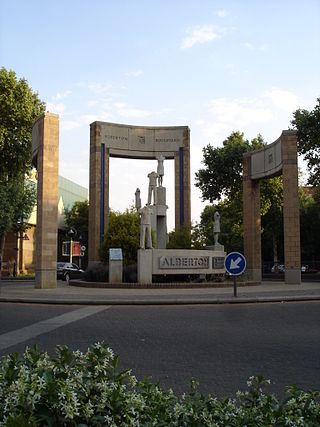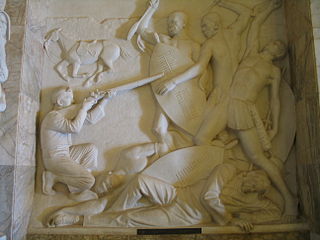
The Great Trek was a Northward migration of Dutch-speaking settlers who travelled by wagon trains from the Cape Colony into the interior of modern South Africa from 1836 onwards, seeking to live beyond the Cape's British colonial administration. The Great Trek resulted from the culmination of tensions between rural descendants of the Cape's original European settlers, known collectively as Boers, and the British Empire. It was also reflective of an increasingly common trend among individual Boer communities to pursue an isolationist and semi-nomadic lifestyle away from the developing administrative complexities in Cape Town. Boers who took part in the Great Trek identified themselves as voortrekkers, meaning "pioneers", "pathfinders" in Dutch and Afrikaans.

The Boer republics were independent, self-governing republics formed by Dutch-speaking inhabitants of the Cape Colony and their descendants. The founders – variously named Trekboers, Boers and Voortrekkers – settled mainly in the middle, northern, north-eastern and eastern parts of present-day South Africa. Two of the Boer Republics achieved international recognition and complete independence: the South African Republic and the Orange Free State. The republics did not provide for the separation of church and state, initially allowing only the Dutch Reformed Church, and later also other Protestant churches in the Calvinist tradition. The republics came to an end after the Second Boer War of 1899–1902, which resulted in British annexation and later incorporation of their lands into the Union of South Africa.

Andries Wilhelmus Jacobus Pretorius was a leader of the Boers who was instrumental in the creation of the South African Republic, as well as the earlier but short-lived Natalia Republic, in present-day South Africa. The large city of Pretoria, executive capital of South Africa, is named after him.

Potchefstroom is an academic city in the North West Province of South Africa. It hosts the Potchefstroom Campus of the North-West University. Potchefstroom is on the Mooi Rivier, roughly 120 km (75 mi) west-southwest of Johannesburg and 45 km (28 mi) east-northeast of Klerksdorp.

Andries Hendrik Potgieter, known as Hendrik Potgieter was a Voortrekker leader and the last known Champion of the Potgieter family. He served as the first head of state of Potchefstroom from 1840 and 1845 and also as the first head of state of Zoutpansberg from 1845 to 1852.
Pieter Johannes "Piet" Potgieter was a South African Boer political figure. He was the acting head of state of Zoutpansberg from 1852 to 1854, and the first son of voortrekker Andries Potgieter. He married Elsie Maria Aletta van Heerden, who later married Stephanus Schoeman, a subsequent leader of Zoutpansberg, and acting president of the South African Republic. The town Piet Potgietersrust, now Mokopane, was named in Potgieter's memory in 1907.

The Natalia Republic was a short-lived Boer republic founded in 1839 after a Voortrekker victory against the Zulus at the Battle of Blood River. The area was previously named Natália by Portuguese sailors, due to its discovery on Christmas. The republic came to an end in 1843 when British forces annexed it to form the Colony of Natal. After the British annexation of the Natalia Republic, most local Voortrekkers trekked northwest into Transorangia, later known as the Orange Free State, and the South African Republic.

Alberton is a city situated on the southern part of the East Rand of the Gauteng Province in South Africa and is situated very close to the major urban centre of Johannesburg.

Winburg is a small mixed farming town in the Free State province of South Africa.
Fochville is a farming and mining town located in the Gauteng province of South Africa. It is part of the Merafong City Local Municipality, which also includes Kokosi, Carletonville and Khutsong. The area surrounding Fochville contains Sotho or Tswana ruins. Tlokwe Ruins are the remains of Sotho-Tswana settlements on the hills surrounding Fochville that were inhabited until the 1820s. Boer War hero Danie Theron was killed 5 km north of the town. The town itself was established as an agricultural centre in 1920 and was named after the World War I commander-in-chief of the Allied forces in France, Marshal of France Ferdinand Foch.
The following lists events that happened during 1844 in South Africa.

Pieter Mauritz Retief was a Voortrekker leader. Settling in 1814 in the frontier region of the Cape Colony, he assumed command of punitive expeditions in response to raiding parties from the adjacent Xhosa territory. He became a spokesperson for the frontier farmers who voiced their discontent, and wrote the Voortrekkers' declaration at their departure from the colony.

The Battle of Italeni was a battle that took place at 28°29′6″S31°16′27″E in what is now KwaZulu Natal province, South Africa, between the Voortrekkers and the Zulus during the period of the Great Trek.

Petrus Lafras Uys (1797–1838) was a Voortrekker leader during the Great Trek.

The flag of the Natalia Republic was the official flag of this short-lived South African state, which existed from 1839 to 1843.
Schoemansdal was a settlement situated 16 km west of Louis Trichardt (Makhado), which had its origins during the Great Trek. It existed from 1848 to 1867, and functioned as the capital of an autonomous region until the S.A.R. Volksraad was established, when the outpost came under the supervision and regulations of the central government. The settlement was evacuated after only thirty years when attacked by Venda militants. The government rendered indecisive support and the town as torched by Katze-Katze on the night of 15 July 1867.
Voortrekker Fort/Ohrigstad Fort was constructed before 1847 to act as a refuge for local Voortrekker families due to the constant attacks of local Bantu tribes. It is situated in the Ohrigstad area of northern Mpumalanga province which was first settled by Europeans under the leadership of Andries Hendrik Potgieter.
Jan Gerritze Bantjes was a Voortrekker whose exploration of the Natal and subsequent report were the catalyst for mobilising the Great Trek. He was also the author of the treaty between the Zulu king Dingane kaSenzangakhona and the Voortrekkers under Andries Pretorius.
The Potchefstroom Reformed Church (in Potchefstroom, North West, South Africa, is the oldest congregation of the Dutch Reformed Church in South Africa in what was then the Transvaal or South African Republic. At its founding in March 1842, it was the 28th congregation in what would later become South Africa and the tenth outside of the Western and Southern Cape Synod.










